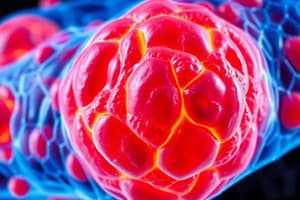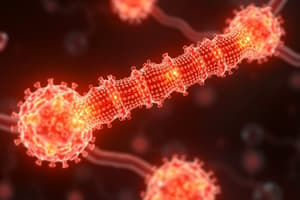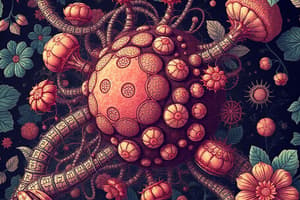Podcast
Questions and Answers
What is the main tissue type from which lipoma develops?
What is the main tissue type from which lipoma develops?
- Nervous tissue
- Connective tissue
- Muscle tissue
- Adipose tissue (correct)
Which statement is true regarding hemangiomas?
Which statement is true regarding hemangiomas?
- They typically arise as bluish, purple, or red spots. (correct)
- They can only occur in adults.
- They are always present at birth.
- They are malignant tumors.
What is the recommended treatment for lymphangiomas?
What is the recommended treatment for lymphangiomas?
- Chemotherapy
- Surgery or sclerotherapy (correct)
- Radiation therapy
- Topical ointment
Which condition corresponds to varicocele in men?
Which condition corresponds to varicocele in men?
What is a characteristic feature of papillomas?
What is a characteristic feature of papillomas?
Which treatment options are effective for hemangiomas?
Which treatment options are effective for hemangiomas?
What kind of mutations are often observed in lymphangiomas?
What kind of mutations are often observed in lymphangiomas?
Which type of tumor is most commonly associated with overweight patients during pregnancy?
Which type of tumor is most commonly associated with overweight patients during pregnancy?
What is the primary characteristic of paraovarian cysts?
What is the primary characteristic of paraovarian cysts?
Which of the following is NOT a correct description of follicular cysts?
Which of the following is NOT a correct description of follicular cysts?
What condition is characterized by the presence of both ovarian fibromas and hydrothorax?
What condition is characterized by the presence of both ovarian fibromas and hydrothorax?
Which benign tumor type can secrete estrogen?
Which benign tumor type can secrete estrogen?
What percentage of cases affect the body of the uterus compared to the cervix?
What percentage of cases affect the body of the uterus compared to the cervix?
Which symptom is considered classic for symptomatic fibroids?
Which symptom is considered classic for symptomatic fibroids?
Which diagnostic method is least likely to be used routinely for diagnosing fibroids?
Which diagnostic method is least likely to be used routinely for diagnosing fibroids?
What type of fibroid grows into the thickness of the uterine wall?
What type of fibroid grows into the thickness of the uterine wall?
What is a potential consequence of fibroids related to pregnancy?
What is a potential consequence of fibroids related to pregnancy?
Which method is specifically helpful in detecting submucous fibroids in unexplained infertility?
Which method is specifically helpful in detecting submucous fibroids in unexplained infertility?
What type of growth is classified as atypical in fibroids?
What type of growth is classified as atypical in fibroids?
During an abdominal examination, how might an enlarged uterine body feel?
During an abdominal examination, how might an enlarged uterine body feel?
Which of the following is NOT a symptom commonly associated with fibroids?
Which of the following is NOT a symptom commonly associated with fibroids?
What is the most common histological type of benign ovarian tumor?
What is the most common histological type of benign ovarian tumor?
Which benign ovarian tumor is most commonly associated with hyperestrogenism?
Which benign ovarian tumor is most commonly associated with hyperestrogenism?
What percentage of benign ovarian tumors are tumor-like processes?
What percentage of benign ovarian tumors are tumor-like processes?
Which symptom is NOT commonly associated with ovarian masses?
Which symptom is NOT commonly associated with ovarian masses?
What is the foremost prognostic factor in the course of ovarian tumors?
What is the foremost prognostic factor in the course of ovarian tumors?
Which of the following tumors is classified as a benign sex cord/stromal tumor?
Which of the following tumors is classified as a benign sex cord/stromal tumor?
Which type of cyst is characterized by the presence of theca and lutein cells?
Which type of cyst is characterized by the presence of theca and lutein cells?
What type of cyst is defined as a tumor-like process that can be mistaken for a true neoplasm?
What type of cyst is defined as a tumor-like process that can be mistaken for a true neoplasm?
Which of the following is NOT a type of neoplastic benign ovarian tumor?
Which of the following is NOT a type of neoplastic benign ovarian tumor?
In postmenopausal women, what symptom may signal a hormone-producing ovarian tumor?
In postmenopausal women, what symptom may signal a hormone-producing ovarian tumor?
What symptom is primarily associated with lateral cervical fibroids?
What symptom is primarily associated with lateral cervical fibroids?
Which treatment is specifically suggested presurgically to manage leiomyomas?
Which treatment is specifically suggested presurgically to manage leiomyomas?
What is a significant risk associated with large fibroids?
What is a significant risk associated with large fibroids?
Which condition is NOT part of the differential diagnosis for leiomyoma?
Which condition is NOT part of the differential diagnosis for leiomyoma?
Which procedure is generally used for asymptomatic fibroids?
Which procedure is generally used for asymptomatic fibroids?
What complication can arise specifically due to ischemia of fibroid nodes?
What complication can arise specifically due to ischemia of fibroid nodes?
What condition can cause renal complications due to pressure from fibroids?
What condition can cause renal complications due to pressure from fibroids?
Which therapeutic option is categorized as a medical treatment for leiomyoma?
Which therapeutic option is categorized as a medical treatment for leiomyoma?
In the PALM-COEIN classification, what does 'P' stand for?
In the PALM-COEIN classification, what does 'P' stand for?
Which surgical procedure is commonly performed to remove fibroids?
Which surgical procedure is commonly performed to remove fibroids?
Flashcards
Lipoma
Lipoma
A benign tumor formed from adipose tissue, typically in the pubic area and labia major, characterized by soft consistency.
Myxoma (Nuck's Diverticulum)
Myxoma (Nuck's Diverticulum)
A benign tumor arising from mesenchymal remnants, usually found in the pubic area subcutaneous tissue; similar to varicocele in men, requiring surgical removal.
Hemangioma
Hemangioma
A benign tumor composed of blood vessels, often found in children, appearing as a bluish/purple/red spot that rapidly increases in size.
Lymphangioma
Lymphangioma
Signup and view all the flashcards
Papilloma
Papilloma
Signup and view all the flashcards
Benign Tumor
Benign Tumor
Signup and view all the flashcards
Surgical Treatment
Surgical Treatment
Signup and view all the flashcards
Uterine Fibroids Localization
Uterine Fibroids Localization
Signup and view all the flashcards
Subserous Fibroid
Subserous Fibroid
Signup and view all the flashcards
Intramural Fibroid
Intramural Fibroid
Signup and view all the flashcards
Submucous Fibroid
Submucous Fibroid
Signup and view all the flashcards
Atypical Fibroid
Atypical Fibroid
Signup and view all the flashcards
Fibroid Diagnosis - Physical Exam
Fibroid Diagnosis - Physical Exam
Signup and view all the flashcards
Fibroid Diagnosis - Imaging (Ultrasound)
Fibroid Diagnosis - Imaging (Ultrasound)
Signup and view all the flashcards
Fibroid Diagnosis - Symptoms
Fibroid Diagnosis - Symptoms
Signup and view all the flashcards
Fibroid Diagnosis- Diagnostic Methodologies
Fibroid Diagnosis- Diagnostic Methodologies
Signup and view all the flashcards
Uterine Curettage
Uterine Curettage
Signup and view all the flashcards
Cervical Fibroid Location
Cervical Fibroid Location
Signup and view all the flashcards
PALM-COEIN
PALM-COEIN
Signup and view all the flashcards
Leiomyoma Complications
Leiomyoma Complications
Signup and view all the flashcards
Leiomyoma Treatment: Surveillance
Leiomyoma Treatment: Surveillance
Signup and view all the flashcards
Medical Treatment for Leiomyoma
Medical Treatment for Leiomyoma
Signup and view all the flashcards
Surgical Treatment for Leiomyoma
Surgical Treatment for Leiomyoma
Signup and view all the flashcards
MRI Guided Focused Ultrasound Surgery
MRI Guided Focused Ultrasound Surgery
Signup and view all the flashcards
Hysterectomy for Fibroids
Hysterectomy for Fibroids
Signup and view all the flashcards
Ovarian Tumors: Prevalence
Ovarian Tumors: Prevalence
Signup and view all the flashcards
Ovarian Tumors: Malignancy Risk
Ovarian Tumors: Malignancy Risk
Signup and view all the flashcards
Ovarian Tumor Prognosis
Ovarian Tumor Prognosis
Signup and view all the flashcards
Follicular Cyst
Follicular Cyst
Signup and view all the flashcards
Corpus Luteum Cyst
Corpus Luteum Cyst
Signup and view all the flashcards
Theca-Lutein Cyst
Theca-Lutein Cyst
Signup and view all the flashcards
Endometrioma Cyst
Endometrioma Cyst
Signup and view all the flashcards
Mature Teratoma (Dermoid Cyst)
Mature Teratoma (Dermoid Cyst)
Signup and view all the flashcards
Serous Cystadenoma
Serous Cystadenoma
Signup and view all the flashcards
Mucinous Cystadenoma
Mucinous Cystadenoma
Signup and view all the flashcards
Ovarian Epithelial Neoplasms
Ovarian Epithelial Neoplasms
Signup and view all the flashcards
Endometrioid Borderline Tumor
Endometrioid Borderline Tumor
Signup and view all the flashcards
Teratoma
Teratoma
Signup and view all the flashcards
Ovarian Fibroma/Thecoma
Ovarian Fibroma/Thecoma
Signup and view all the flashcards
Paraovarian Cyst
Paraovarian Cyst
Signup and view all the flashcards
Study Notes
Lipoma Development
- Lipomas develop mainly from adipose tissue.
Hemangiomas
- Hemangiomas are benign tumors composed of blood vessels.
Lymphangioma Treatment
- The recommended treatment for lymphangiomas is surgical excision.
Varicocele
- Varicocele in men corresponds to the condition of varicose veins in the pampiniform plexus of the spermatic cord.
Papillomas
- A characteristic feature of papillomas is the presence of finger-like projections.
Hemangioma Treatment Options
- Effective treatment options for hemangiomas include surgery, laser therapy, sclerotherapy, and embolization.
Lymphangioma Mutations
- Mutations in the PROX1 and FOXC2 genes are often observed in lymphangiomas.
Pregnancy-Related Tumor
- Fibroids are the most commonly associated tumor with overweight patients during pregnancy.
Paraovarian Cyst
- Paraovarian cysts are characterized by their location adjacent to the ovary and not connected to it.
Follicular Cyst
- Follicular cysts are NOT always filled with fluid.
Meigs' Syndrome
- Meigs' syndrome features both ovarian fibromas and hydrothorax.
Estrogen-Secreting Tumor
- Granulosa cell tumors are a type of benign tumor that can secrete estrogen.
Uterine Fibroid Location
- Approximately 80% of fibroids affect the body of the uterus, while the remaining 20% affect the cervix.
Classic Fibroid Symptom
- Heavy menstrual bleeding is a classic symptom of symptomatic fibroids.
Fibroid Diagnostic Method
- Colposcopy is least likely to be used routinely for diagnosing fibroids.
Intramural Fibroid
- Intramural fibroids grow into the thickness of the uterine wall.
Fibroid Pregnancy Consequence
- Fibroids can lead to complications like preterm labor and miscarriage during pregnancy.
Submucous Fibroid Detection
- Hysteroscopy is particularly helpful in detecting submucous fibroids in unexplained infertility.
Atypical Fibroid Growth
- "Atypical" growth in fibroids refers to cellular atypia, potentially indicating a risk of malignancy.
Enlarged Uterine Body
- During an abdominal examination, an enlarged uterine body may feel firm and irregular.
Fibroid Symptom
- Infertility is NOT a common symptom associated with fibroids.
Benign Ovarian Tumor
- The most common histological type of benign ovarian tumor is the serous cystadenoma.
Hyperestrogenism-Related Tumor
- The granulosa cell tumor is most commonly associated with hyperestrogenism among benign ovarian tumors.
Tumor-Like Processes
- Approximately 25% of benign ovarian tumors are tumor-like processes.
-
An ovarian mass may present with a variety of symptoms, including abdominal discomfort, changes in menstrual cycle, or even pressure symptoms on adjacent organs.
Ovarian Tumor Prognostic Factor
- The size of the tumor is the most important prognostic factor in the course of ovarian tumors.
Benign Sex Cord/Stromal Tumor
- The fibroma is classified as a benign sex cord/stromal tumor.
Tumor-Like Process
- A corpus luteum cyst is a tumor-like process that can be mistaken for a true neoplasm.
Non-Neoplastic Benign Ovarian Tumor
- Endometriomas are NOT a type of neoplastic benign ovarian tumor. They are actually benign cysts arising from endometriosis.
Postmenopausal Symptom
- Postmenopausal bleeding may signal a hormone-producing ovarian tumor.
Lateral Cervical Fibroid Symptom
- Dyspareunia (painful intercourse) is primarily associated with lateral cervical fibroids.
Leiomyoma Presurgical Management
- Gonadotropin-releasing hormone (GnRH) agonists are specifically suggested presurgically to manage leiomyomas.
Large Fibroid Risk
- A significant risk associated with large fibroids is compression of adjacent organs.
Leiomyoma Differential Diagnosis
When considering a differential diagnosis for leiomyomas, it is essential to distinguish them from other uterine or adnexal masses, including smooth muscle tumors, endometrial polyps, and other neoplasms.
Asymptomatic Fibroid Procedure
- Observation is generally used for asymptomatic fibroids.
Fibroid Node Ischemia Complication
- A potential complication arising specifically due to ischemia of fibroid nodes is infarction.
Fibroid-Related Renal Complications
- Hydronephrosis can cause renal complications due to pressure from fibroids.
Leiomyoma Medical Treatment
- GnRH agonists are categorized as a medical treatment for leiomyoma.
The PALM-COEIN classification system is a comprehensive framework used to categorize abnormal uterine bleeding (AUB) based on the etiology of the conditions involved. PALM is an acronym that represents structural causes, while COEIN signifies non-structural causes.
PALM:
- P: Polyps - benign growths on the endometrial surface.
- A: Adenomyosis - presence of endometrial tissue within the muscle of the uterus.
- L: Leiomyoma - also known as fibroids; these are smooth muscle tumors of the uterus.
- M: Malignancy and hyperplasia - includes uterine cancers or precancerous conditions.
COEIN:
- C: Coagulopathy - disorders affecting blood clotting.
- O: Ovulatory dysfunction - irregularities in the menstrual cycle related to anovulation or hormonal imbalances.
- E: Endometrial - issues directly related to the endometrial lining.
- I: Iatrogenic - causes resulting from medical interventions.
- N: Not yet classified - conditions that require further investigation or cannot be readily categorized at present.
This classification allows healthcare providers to systematically identify and address the underlying causes of AUB, ensuring appropriate management strategies are implemented.
- 'P' in the PALM-COEIN classification stands for polyp.
Fibroid Removal Procedure
- Myomectomy is commonly performed to remove fibroids.
Studying That Suits You
Use AI to generate personalized quizzes and flashcards to suit your learning preferences.




